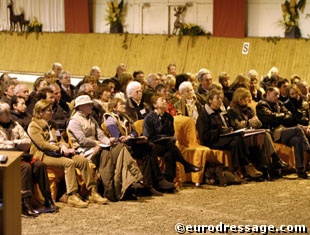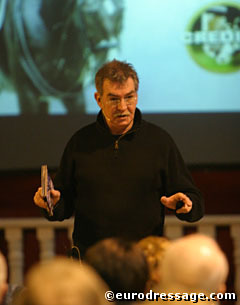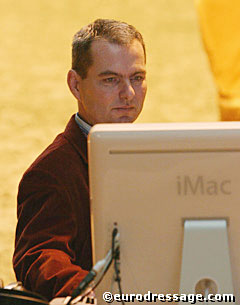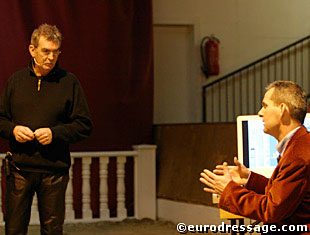
Figure skater Daniel Weiss was the concluding speaker of the first day of the 2005 FEI/PSI Freestyle Forum. In the evening, all guests were invited to a formal dinner at the Steigenberger Remarque hotel in Osnabruck, Germany.
Busses picked up the guests at different hotels and drove us to the Osnabruck Town Hall for a small reception, where the mayor of Osnabruck and Mariette Withages toasted to the success of the forum. Ullrich Kasselmann, foreman of PSI and renowned Osnabrucker citizen, was thanked for his wonderful services in the organization of the freestyle forum. The formal dinner at the hotel was truly wonderful. The atmosphere was pleasant, the food was great and the company (at least at my table, i.e. Claartje van Andel, Kenneth Dyrby, Linda Kennan, Bo Jena) was exceptional.
The formal dinner was a good ice breaker for many attendants at the forum. Consequently, day two of the forum started off in a much more relaxed and settled in atmosphere. Some important changes were also made in the execution of the organization. Because there was only a select group of attendants, chairs were put inside the arena closer to the big screen making the distance between the addresser and addressees smaller and more personal.
Another fact attributed to the success of the second day of the forum, namely the brilliant presentation of Cees Slings and Victor Kerkhof. This Dutch duo is world famous for being the composers of Anky van Grunsven's double Olympic gold medal winning freestyles and in Ankum they revealed the secrets to their success.
Slings and Kerkhof Share Their Recipe
 Cees Slings took his place behind the microphone while Victor Kerkhof sat behind his iMac computer controlling the music and video fragments displayed during their session. Slings opened his speech by saying that they approach a freestyle like a tv-show. "It has to be drama, suspense, a show that is captivating," said Slings. "It has to be one piece of music with a broadcast quality standard."
Cees Slings took his place behind the microphone while Victor Kerkhof sat behind his iMac computer controlling the music and video fragments displayed during their session. Slings opened his speech by saying that they approach a freestyle like a tv-show. "It has to be drama, suspense, a show that is captivating," said Slings. "It has to be one piece of music with a broadcast quality standard."
Slings and Kerkhof have been working with Anky van Grunsven since 1996 and recently designed Anky's latest kur hit, "L'Esprit Chanson". At the forum, Slings showed numerous video clips of the different stages they went through in designing Anky's kur, that earned her gold in Athens.
Step one is the choreography. According to Sjef Janssen, the kur has to be as difficult as possible, but within the ability of the horse. Sjef designs the choreography of Anky's tests, which Slings and Kerkhof video tape at her home. They make movie clips from different angles in order to transfer the ideal clip onto the computer as ground material.
Step two is making a "click track". Kerkhof reviews the video clips and records clicks to the rhythm of the horse. These clicks differ, of course, in walk, trot, canter, piaffe and passage but they are vital to getting an overview of the complete rhythm of the horse.
Slings and Kerkhof then add different layers of music to that rhythm. The composers' duo and Anky and Sjef decided to go for French Chansons, which made it obvious that they selected Edith Piaff as main musical contributor for the piaffe and passage. Because Kerkhof is the main keyboard player and skilled computer tech, he first adds a piano layer of Piaff's "Je ne regrette Rien" to the draught track. Then he gives the music more body by adding a drum beat and a horn melody. When the first layers of music are finished, the duo goes back to Anky's to try out their first draught version of the freestyle.
 The fourth phase is the coring of the music, which means that the different layers are "cored" into a MIDI file (Musical Instrument Digital Interface). Because Slings and Kerkhof like vocals, they came up with the idea to add Anky's voice to the kur. Anky went to the studio to sing "Belle Histoire" for the canter zig zag. "We are very fond of vocals, for instance, in Carmina Burana [Rusty's kur] there is a whole orchestra. The voice works as an instrument," Slings said.
The fourth phase is the coring of the music, which means that the different layers are "cored" into a MIDI file (Musical Instrument Digital Interface). Because Slings and Kerkhof like vocals, they came up with the idea to add Anky's voice to the kur. Anky went to the studio to sing "Belle Histoire" for the canter zig zag. "We are very fond of vocals, for instance, in Carmina Burana [Rusty's kur] there is a whole orchestra. The voice works as an instrument," Slings said.
Slings and Kerkhof went to Anky's for a kur try out at least five times. The major problem with creating this freestyle was that Salinero was rapidly improving. He was getting stronger and more confirmed in the Grand Prix movements, which constantly changed the rhythm of his gaits. Anky rode the Esprit Chanson freestyle for the first time at the CDI-W Maastricht in December 2003, but the kur changed seven or more times before its final version for Athens.
"We want to have broadcast quality, so knowing that Athens was going to be outside with lots of wind, we chose for a flugelhorn (a low key-trumpet) for the walk. This sound of the flugelhorn is carried by the wind, while a flute or oboe, for instance, stop dead," Slings explained. The duo considers the walk part a phase in which rider and horse can take a deep breath and start again for the final part of the kur. For L'Esprit Chanson, they used real instruments to give the kur more body. "Real instruments have more depth and vibration and come to life in a freestyle," Slings explained.
 At the forum, Slings and Kerkhof made it all look so easy, to design a gold medal winning freestyle, but what they did not discuss was the actual price tag that is attached to such a professional, broadcast quality kur. Adding live instruments to a freestyle is expensive and not always necessary. Anky's West Side Story kur, for instance, is completely digitally made with samples and is to date her best freestyle. Slings and Kerkhof also announced that from now on they will no longer work exclusively for Anky van Grunsven. They are ready to take on new customers and are currently negotiating with several top international dressage riders. "We had a gentleman's agreement that we would work only for Anky up to the 2004 Olympics in Athens," Slings commented. Even though the cost for a Slings/Kerkhof kur is high (think at least 18,000 euro and more), their compositions are to date still the best in the dressage world. The more professional musical freestyles are made, the more interesting the Grand Prix kur to music will get. Win two big international shows with such a high tech kur and you've got your money back. Or is it too simplistic to see it like that?
At the forum, Slings and Kerkhof made it all look so easy, to design a gold medal winning freestyle, but what they did not discuss was the actual price tag that is attached to such a professional, broadcast quality kur. Adding live instruments to a freestyle is expensive and not always necessary. Anky's West Side Story kur, for instance, is completely digitally made with samples and is to date her best freestyle. Slings and Kerkhof also announced that from now on they will no longer work exclusively for Anky van Grunsven. They are ready to take on new customers and are currently negotiating with several top international dressage riders. "We had a gentleman's agreement that we would work only for Anky up to the 2004 Olympics in Athens," Slings commented. Even though the cost for a Slings/Kerkhof kur is high (think at least 18,000 euro and more), their compositions are to date still the best in the dressage world. The more professional musical freestyles are made, the more interesting the Grand Prix kur to music will get. Win two big international shows with such a high tech kur and you've got your money back. Or is it too simplistic to see it like that?